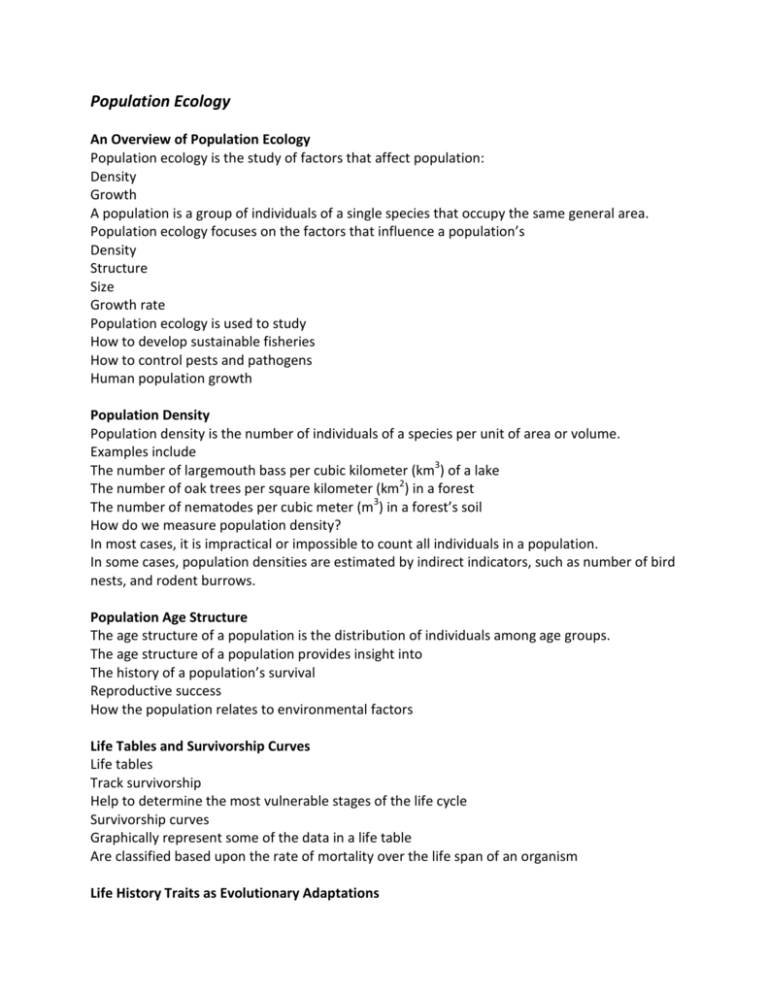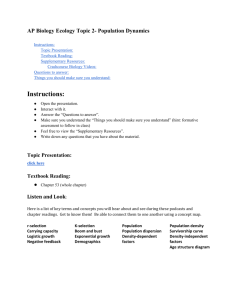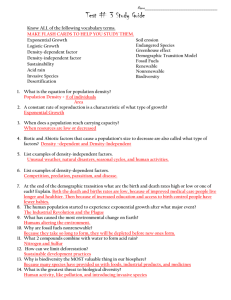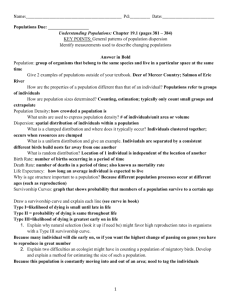Population Ecology
advertisement

Population Ecology An Overview of Population Ecology Population ecology is the study of factors that affect population: Density Growth A population is a group of individuals of a single species that occupy the same general area. Population ecology focuses on the factors that influence a population’s Density Structure Size Growth rate Population ecology is used to study How to develop sustainable fisheries How to control pests and pathogens Human population growth Population Density Population density is the number of individuals of a species per unit of area or volume. Examples include The number of largemouth bass per cubic kilometer (km3) of a lake The number of oak trees per square kilometer (km2) in a forest The number of nematodes per cubic meter (m3) in a forest’s soil How do we measure population density? In most cases, it is impractical or impossible to count all individuals in a population. In some cases, population densities are estimated by indirect indicators, such as number of bird nests, and rodent burrows. Population Age Structure The age structure of a population is the distribution of individuals among age groups. The age structure of a population provides insight into The history of a population’s survival Reproductive success How the population relates to environmental factors Life Tables and Survivorship Curves Life tables Track survivorship Help to determine the most vulnerable stages of the life cycle Survivorship curves Graphically represent some of the data in a life table Are classified based upon the rate of mortality over the life span of an organism Life History Traits as Evolutionary Adaptations Key life history traits are the Age at first reproduction Frequency of reproduction Number of offspring Amount of parental care provided Life history traits evolve Represent a compromise of the competing needs for time, energy, and nutrients. Organisms with an opportunistic life history Take immediate advantage of favorable conditions Typically exhibit a Type III survivorship curve Organisms with an equilibrial life history Reach sexual maturity slowly Produce few, well cared for offspring Are typically large-bodied and longer lived Typically exhibit a Type I survivorship curve Population Growth Models Population size fluctuates as individuals are born Immigrate into an area Emigrate away Die The Exponential Growth Model Exponential population growth describes the expansion of a population in an ideal and unlimited environment. Exponential growth explains how a few dozen rabbits can multiple into millions In certain circumstances following disasters, organisms that have opportunistic life history patterns can rapidly recolonize a habitat The Logistic Growth Model Limiting factors Are environmental factors that hold population growth in check Restrict the number of individuals that can occupy a habitat The carrying capacity is the maximum population size that a particular environment can sustain. Logistic population growth occurs when the growth rate decreases as the population size approaches carrying capacity. The carrying capacity for a population varies, depending on the species The resources available in the habitat Organisms exhibiting equilibrial life history patterns occur in environments where the population size is at or near carrying capacity. The logistic model and the exponential model are theoretical ideals of population growth. No natural population fits either one perfectly. Regulation of Population Growth Density-Dependent Factors The logistic model is a description of intraspecific competition, competition between individuals of the same species for the same limited resources. As population size increases competition becomes more intense The growth rate declines in proportion to the intensity of competition A density-dependent factor is a population-limiting factor whose effects intensify as the population increases in density. Density-dependent factors may include accumulation of toxic wastes Limited food supply Limited territory Density-Independent Factors Density-independent factors Are population-limiting factors whose intensity is unrelated to population density Include abiotic factors such as fires, floods, and storms In many natural populations, density-independent factors limit population size before densitydependent factors become important. Over the long term, most populations are probably regulated by a mixture of Density-independent factors Density-dependent factors Population Cycles A well studied example of boom and bust cycles are the cycles of Snowshoe hares One of the hares’ predators, the lynx The cause of these hare and lynx cycles may be Winter food shortages for the hares Overexploitation of hares by lynx A combination of both of these mechanisms Applications of Population Ecology Population ecology is used to Increase populations of organisms we wish to harvest Decrease populations of pests Save populations of organisms threatened with extinction Conservation of Endangered Species The U.S. Endangered Species Act defines an endangered species as one that is in danger of extinction throughout all or a significant portion of its range A threatened species as one that is likely to become endangered in the foreseeable future A major factor in population decline is habitat destruction or modification. The red-cockaded woodpecker Requires longleaf pine forests with clear flight paths between trees Suffered from fire suppression, increasing the height of the vegetation on the forest floor Recovered from near-extinction to sustainable populations due to controlled burning and other management methods Sustainable Resource Management According to the logistic growth model, the fastest growth rate occurs when a population size is at roughly half the carrying capacity. Theoretically, populations should be harvested down to this level, assuming that growth rate and carrying capacity are stable over time. In the northern Atlantic cod fishery Estimates of cod stocks were too high The practice of discarding young cod (not of legal size) at sea caused a higher mortality rate than was predicted The fishery collapsed in 1992 and has not recovered Invasive Species An invasive species Is a non-native species that has spread far beyond the original point of introduction Causes environmental or economic damage by colonizing and dominating suitable habitats In the United States, invasive species cost about $137 billion a year. Invasive species typically exhibit an opportunistic life history pattern. Cheatgrass is an invasive species in the western United States Currently covers more than 60 million acres of rangeland formerly dominated by native grasses and sagebrush Produces seeds earlier and in greater abundance than native species Forms highly flammable brush creating fires that native plants cannot tolerate European starlings are another invasive species Were first released into New York in 1890 Now number more than 200 million in the United States Biological Control of Pests Invasive species may benefit from the absence of Pathogens Predators Herbivores Biological control is the intentional release of a natural enemy to attack a pest population Is used to manage an invasive species In 1950, the Australian government introduced a virus lethal to European rabbits into the rabbits’ Australian environment. Although initially successful, natural selection favored Resistant rabbits Variations of the virus that were not fatal or killed their hosts more slowly Evolutionary changes such as these, in which an adaptation of one species leads to a counteradaptation in a second species, are known as coevolution. Integrated Pest Management Agricultural operations create their own highly managed ecosystems that have genetically similar individuals (a monoculture) Are planted in close proximity to each other Function as a “banquet” for plant-eating animals, pathogenic bacteria, and viruses Like invasive species, most crop pests have an opportunistic life history pattern Can cause extensive crop damage Pesticides may result in pesticide-resistant pests Kill the pest and their natural predators Kill pollinators Human Population Growth From 2000 to 500 years ago (in 1500) Mortality was high Births and deaths were about equal The world population held steady at about 300 million The world’s population began to grow exponentially in the 1900s due to advances in Nutrition Sanitation Health care Worldwide population growth rates reflect a mosaic of the changes occurring in different countries. In the most developed nations, the overall growth rates are near zero. In the developing world death rates have dropped, and high birth rates persist Age Structures Age structures help predict a population’s future growth. The following figure shows the estimated and projected age structures of Mexico’s population in 1985 2010 2035 Population momentum is the continuation of population growth as girls in the prereproductive age group reach their reproductive years. Age structure diagrams may also indicate social conditions. An expanding population needs Schools Employment Infrastructure Trends in the age structure of the United States from 1983 to 2033 reveal important patterns. Our Ecological Footprint An ecological footprint is an estimate of the amount of land required to provide the raw materials an individual or a population consumes, including: Food Fuel Water Housing Waste disposal The ecological footprint of the United States is 9.4 hectares per person Represents almost twice what the U.S. land and resources can support. The ecological impact of affluent nations is a problem of overconsumption, not overpopulation. Compared to a family in rural India, Americans have an abundance of possessions. There is tremendous disparity in consumption throughout the world. The world’s richest countries have 20% of the global population Use 86% of the world’s resources The rest of the world Has 80% of the population Uses just 14% of global resources







